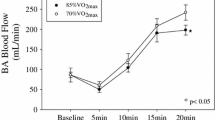Summary
In 9 healthy subjects the effect of smoking one cigarette (nicotine content 0.9 mg) on blood pressure, heart rate and total and muscle blood flow in the forearm was measured.
Blood flow was measured by a new noninvasive plethysmographic method that simultaneously gives quantitative data about total and muscle blood flow.
Smoking the cigarette did not significantly affect blood pressure or heart rate. Total blood flow in the forearm did not change but the flow to the muscle was increased and resistance in this vascular bed was decreased.
The pattern of haemodynamic changes in the forearm indicates that epinephrine may be the mediator of the circulatory effects of nicotine.
Similar content being viewed by others
References
Benowitz NL (1986) Clinical pharmacology of nicotine. Ann Rev Med 37: 21–32
Benowitz NL, Jacob P III, Jones RT, Rosenberg J (1982) Interindividual variability in the metabolism and cardiovascular effects of nicotine in man. J Pharmacol Exp Ther 221: 368–372
Benowitz NL, Porchet H, Sheiner L, Jacob P III (1988) Nicotine absorption and cardiovascular effects with smokeless tobacco use: Comparison with cigarettes and nicotine gum. Clin Pharmacol Ther 44: 23–28
Canale JM, Aceves-Tavares GR, Ramos-Salas E (1987) Cardiovascular effects immediate to the inhalation of tobacco smoke with different concentrations of nicotine. Arch Inst Cardiol Mex 57: P57-P61
Coffman JD, Javett SL (1963) Blood flow in the human calf during tobacco smoking. Circulation 28: 932–937
Cryer PE, Haymond MW, Santiago JV, Shah SD (1976) Norepinephrine and epinephrine release and adrenergic mediation of smoking-associated hemodynamic and metabolic events. N Engl J Med 295: 573–577
Greenfield ADM, Whitney RI, Mowbray JF (1963) Methods for the investigation of peripheral blood flow. Br Med Bull 19: 101–109
Hensel H, Ruef J, Golenhofen K (1955) Human muscle and skin blood flow: The effect of vasoactive substances. Angiology 6: 190–207
Kershbaum A, Khorsandian R, Caplan RF, Bellet S, Feinberg LJ (1963) The role of catecholamines in the free fatty acid responses to cigarette smoking. Circulation 28: 52–57
Kety SS (1949) Measurement of regional circulation by the local clearance of radioactive sodium. Am Heart J 38: 321–328
Mjøs OD (1988) Lipid effects of smoking. Am Heart J 115: 272–275
Mjøs OD, Akre S (1971) Effect of catecholamines on blood flow, oxygen consumption, and release/uptake of free fatty acids in adipose tissue. Scand J Clin Lab Invest 27: 221–225
Pocock ST, Hughes MD, Lee RJ (1987) Statistical problems in the reporting of clinical trials. A survey of three medical journals. N Engl J med 317: 426–432
Robertson D, Tseng CJ, Appalsamy M (1988) Smoking and mechanisms of cardiovascular control. Am Heart J 115: 258–262
Roddie IC, Wallace WFM (1979) Methods for the assessment of the effects of drugs on the arterial system in man. Br J Clin Pharmacol 7: 317–323
Rottenstein H, Peirce G, Russ E, Felder DJ, Montgomery H (1959) Effect of nicotine on muscle blood flow in man. Circulation 20: 760
Ruef J, Bock KD, Hensel H (1955) Über die Wirkung des Rauchens auf die Muskeldurchblutung. Z Kreislaufforschg 44: 272–278
Simon DL, Iglauer A, Braunstein J (1954) The immediate effect of cigarettes on the circulation of healthy and habitual male smokers. Am Heart J 48: 185–188
Solti F, Krasznai I, Rév J, Nagy J (1966) Über die akute Wirkung des Nikotins auf den Extremitätenkreislauf. Acta Med Acad Sci Hung 22: 325–334
Tachmes L, Fernandez RJ, Sackner M (1978) Hemodynamic effects of smoking cigarettes of high and low nicotine content. Chest 74: 243–246
Trap-Jensen J (1988) Effects of smoking on the heart and peripheral circulation. Am Heart J 115: 263–266
Trap-Jensen J, Carlsen JE, Svendsen TL, Christensen NJ (1979) Cardiovascular and adrenergic effects of cigarette smoking during immediate non-selective and selective beta-adrenoceptor blockade in humans. Eur J Clin Invest 9: 181–183
Weber F, Anlauf M, Serdarevic M (1988) Noninvasive, quantitative determination of muscle blood flow in man by a combination of venous-occlusion plethysmography and computed tomography. Basic Res Cardiol 83: 327–341
Whelan RF, de la Lande IS (1963) Action of adrenaline on limb blood flow. Br Med Bull 19: 125–131
Author information
Authors and Affiliations
Rights and permissions
About this article
Cite this article
Weber, F., Anlauf, M. & Müller, R.D. Changes in muscle blood flow after smoking a cigarette determined by a new noninvasive method. Eur J Clin Pharmacol 37, 517–520 (1989). https://doi.org/10.1007/BF00558134
Received:
Accepted:
Issue Date:
DOI: https://doi.org/10.1007/BF00558134




